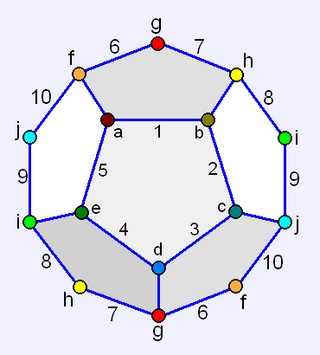Top Qs
Timeline
Chat
Perspective
Hemi-dodecahedron
Abstract regular polyhedron with 6 pentagonal faces From Wikipedia, the free encyclopedia
Remove ads
In geometry, a hemi-dodecahedron is an abstract, regular polyhedron, containing half the faces of a regular dodecahedron. It can be realized as a projective polyhedron (a tessellation of the real projective plane by 6 pentagons), which can be visualized by constructing the projective plane as a hemisphere where opposite points along the boundary are connected and dividing the hemisphere into three equal parts.
It has 6 pentagonal faces, 15 edges, and 10 vertices.
Remove ads
Projections
It can be projected symmetrically inside of a 10-sided or 12-sided perimeter:
Petersen graph
From the point of view of graph theory this is an embedding of the Petersen graph on a real projective plane. With this embedding, the dual graph is K6 (the complete graph with 6 vertices) --- see hemi-icosahedron.

See also
- 57-cell – an abstract regular 4-polytope constructed from 57 hemi-dodecahedra.
- hemi-icosahedron
- hemi-cube
- hemi-octahedron
References
- McMullen, Peter; Schulte, Egon (December 2002), "6C. Projective Regular Polytopes", Abstract Regular Polytopes (1st ed.), Cambridge University Press, pp. 162–165, ISBN 0-521-81496-0
External links
Wikiwand - on
Seamless Wikipedia browsing. On steroids.
Remove ads


